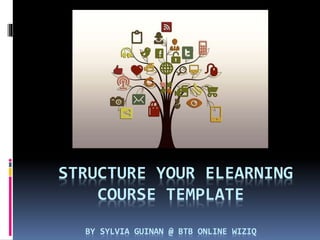
Structure your elearning course
- 1. STRUCTURE YOUR ELEARNING COURSE TEMPLATE BY SYLVIA GUINAN @ BTB ONLINE WIZIQ
- 2. The purpose of this template This template is just for sharing a simple planning layout. I have deliberately left it devoid of design features for two reasons. 1) It’s best to plan the skeleton first and later decide on the look and feel of the course, based on objectives etc. 2) When your template is ready it will be easier to visualise the course and you’ll be able to focus clearly. I’ll also be available to help with that part of the course creation. 3) What do I mean by design? Your elearning power point or other software need not necessarily be textual and linear. The course structure could also be depicted through infographics, mindmaps, white space or smart art designs. The fun partepicted through resented on a mind map or tree, as in the first slide.
- 3. Suggested Template Contents Course Cover Design (welcome screen) Course Description (or similar introduction) Objectives What students will have achieved by the end of the course. Course Content Themes, topics, exercises, quests, challenges. Assessment Tests & tools? Summary What students have covered. Next Steps Advice for autonomous learning, resources, virtual library etc.? Inspired by and adapted from the rapid elearning blog
- 4. A quick guide to ecourse layout This template is to guide your course creation. It’s a suggested blueprint to encourage focus and clarity. It does not dictate the style of your own unique course.
- 5. Course Cover Design Think about who your students are, what they want to learn and then frame your cover design accordingly. You may be able to trigger interest through carefully linking imagery and metaphor to your course title. Write a little blurb, just like they have on book covers. Think of the user-experience. How will the course cover look from their perspectives?
- 6. Course Description Think of your target audience. Who do you think your potential students will be? Frame your course description in ways they can relate to and get excited about. Explain how the course works in very simple steps. Perhaps add a ‘how-to’ video to walk them through the course.
- 7. Objectives As course creator you know your objectives. Students will also want to have clearly defined goals. The course creation tools on WiziQ intuitively guide you through writing the objectives. Here’s a short article on writing elearning objectives.
- 8. Course content one Suggested publishing software. Powerpoint for virtual classroom. You Tube videos for virtual classroom. Google Drive & LMS for everything. (uploaded files, links etc) On the WiziQ learning management system you can embed or link to any kind of software you wish, such as Articulate Storyline, Prezi, google drive etc.
- 9. Course content 2 Keep it simple. Keep it visual. Keep it open to creativity. Make sure it’s user-friendly. Feed in multi-media only when it enhances the learning experience. Link to deeper content so as not to crowd powerpoints with too much text. Files, embeds, videos etc. can all be uploaded to the LMS too.
- 10. Assessment Quiz Tools Digital Learning Missions Webquests Traditional tests/exams Assignment tools
- 11. Summary The summary should make students feel: Satisfied. Inspired. Successful. Hungry for more. You can describe how they have achieved their objectives and how they can continue to succeed and take their learning to the next level.
- 12. Next steps one Tell students how they can easily expand upon their learning. Provide them with a virtual library of links to help them continue to learn autonomously. Give them the option of signing up for more courses with you and/or signing up for your newsletter (if you have one) or just ask them to follow your blog or activity on social media.
- 13. Next Steps two As you embark on your course creation you should develop a taste for, even an obsession for professional development. As far as course creation is concerned, I learn a lot from: Christopher Pappas and authors from the elearning industry. Tom Buchanan and The rapid elearning blog Nicky Hockly and The emoderation station David Deubelbeiss – eflclassroom 2.o & Linkedin group Ellen Finkestein has a great powerpoint blog
- 14. Virtual library New collection on Pearl trees – building up throughout part two of this course. Other tools for creating virtual libraries. 1) Listly 2) Tackk 3) Symbaloo
